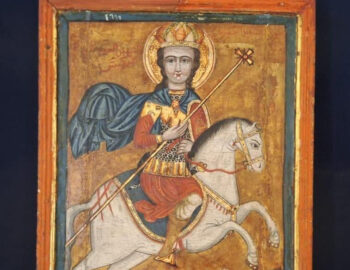The Coptic Museum in Old Cairo has marked the Coptic New Year 1741 AM, celebrated on 11 September, with a temporary exhibition themed “Knight Martyrs”. These saints were those who were cavaliers in the army but were martyred for their Christian faith. Famous among them is St George, St Mercurius, the Egyptian St Menas, St Theodore, and others.
11 September, with a temporary exhibition themed “Knight Martyrs”. These saints were those who were cavaliers in the army but were martyred for their Christian faith. Famous among them is St George, St Mercurius, the Egyptian St Menas, St Theodore, and others.
The exhibition opened on 11 September 2024 and runs for 30 days.
Jehan Atef, Director General of the Coptic Museum, explained that the exhibition aims to highlight the status of the martyrs in the history of the Coptic Church. The exhibition displays them with images inscribed or painted on stone, textile, manuscripts, and in icons.
The exhibition showcases seven artefacts from the museum’s collections of icons of knight martyrs, such as an icon depicting Mar-Girgis (St George) on his horse holding his spear and stabbing the devil with it. Another icon of St George goes back to the 18th century and is signed by Yuhanna al-Armani, John the Armenian. It shows St George in military uniform, riding a horse, wearing a crown on his head; the devil is depicted in the form of a dragon fallen under St George’s horse.
A piece of Coptic textile depicts in its centre an oval shape that includes a knight; it is surrounded at the corners with four ovals each containing a depiction of a knight saint.
There is also a lime tombstone ornamented with a knight martyr on a horse, extending his hand back to hold a flower. Above, an angel crowns the saint with a wreath.
On display are also three manuscripts that include texts which express the honour given to martyrs in Coptic history. Two of the manuscripts come from among the Hamuli manuscripts unearthed in 1910 close to the relics of the monastery of the Angel in Hamuli, west of Fayoum which lies some 100km southwest Cairo. The first manuscript shows St Isidore, and the second St Theodore.
As to the third manuscript, it is part of the Coptic Synaxarium, the book that includes the daily chronicle of saints and martyrs.
The Coptic Museum in Old Cairo is the largest museum of Coptic antiquities in the world, displaying diverse and rare collections of Coptic art. The idea of its establishment began in 1898, when Egypt’s Committee for the Preservation of Arab Antiquities recommended its establishment as an Egyptian State museum. That was following the huge efforts of Markus Pasha Simaika, a prominent Copt who was passionate about Coptic heritage and who was able to gather an impressive collection of Coptic artefacts which he displayed in a museum at Muallaqa Church in Old Cairo. The current museum was opened in 1910. In 1947, a new pavilion was added.
The Coptic Museum underwent several renovations, the last was in 2006, when the old and new pavilions of the museum were connected by a passageway. — Wataninet





